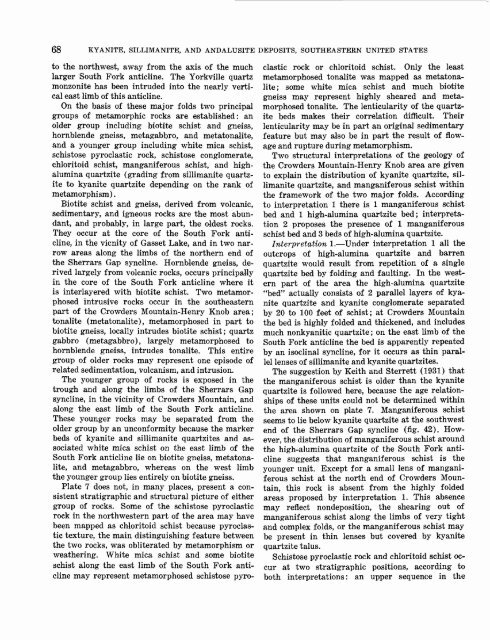Kyanite, Sillimanite, and Andalusite Deposits of the Southeastern ...
Kyanite, Sillimanite, and Andalusite Deposits of the Southeastern ...
Kyanite, Sillimanite, and Andalusite Deposits of the Southeastern ...
Create successful ePaper yourself
Turn your PDF publications into a flip-book with our unique Google optimized e-Paper software.
68 KYANITE, SILLIMANITE, AND ANDALUSITE DEPOSITS, SOUTHEASTERN UNITED STATES<br />
to <strong>the</strong> northwest, away from <strong>the</strong> axis <strong>of</strong> <strong>the</strong> much<br />
larger South Fork anticline. The Yorkville quartz<br />
monzonite has been intruded into <strong>the</strong> nearly vertical<br />
east limb <strong>of</strong> this anticline.<br />
On <strong>the</strong> basis <strong>of</strong> <strong>the</strong>se major folds two principal<br />
groups <strong>of</strong> metamorphic rocks are established: an<br />
older group including biotite schist <strong>and</strong> gneiss,<br />
hornblende gneiss, metagabbro, <strong>and</strong> metatonalite,<br />
<strong>and</strong> a younger group including white mica schist,<br />
schistose pyroclastic rock, schistose conglomerate,<br />
chloritoid schist, manganiferous schist, <strong>and</strong> highalumina<br />
quartzite (grading from sillimanite quartzite<br />
to kyanite quartzite depending on <strong>the</strong> rank <strong>of</strong><br />
metamorphism).<br />
Biotite schist <strong>and</strong> gneiss, derived from volcanic,<br />
sedimentary, <strong>and</strong> igneous rocks are <strong>the</strong> most abundant,<br />
<strong>and</strong> probably, in large part, <strong>the</strong> oldest rocks.<br />
They occur at <strong>the</strong> core <strong>of</strong> <strong>the</strong> South Fork anticline,<br />
in <strong>the</strong> vicnity <strong>of</strong> Gasset Lake, <strong>and</strong> in two narrow<br />
areas along <strong>the</strong> limbs <strong>of</strong> <strong>the</strong> nor<strong>the</strong>rn end <strong>of</strong><br />
<strong>the</strong> Sherrars Gap syncline. Hornblende gneiss, derived<br />
largely from volcanic rocks, occurs principally<br />
in <strong>the</strong> core <strong>of</strong> <strong>the</strong> South Fork anticline where it<br />
is interlayered with biotite schist. Two metamorphosed<br />
intrusive rocks occur in <strong>the</strong> sou<strong>the</strong>astern<br />
part <strong>of</strong> <strong>the</strong> Crowders Mountain-Henry Knob area;<br />
tonalite (metatonalite), metamorphosed in part to<br />
biotite gneiss, locally intrudes biotite schist; quartz<br />
gabbro (metagabbro), largely metamorphosed to<br />
hornblende gneiss, intrudes tonalite. This entire<br />
group <strong>of</strong> older rocks may represent one episode <strong>of</strong><br />
related sedimentation, volcanism, <strong>and</strong> intrusion.<br />
The younger group <strong>of</strong> rocks is exposed in <strong>the</strong><br />
trough <strong>and</strong> along <strong>the</strong> limbs <strong>of</strong> <strong>the</strong> Sherrars Gap<br />
syncline, in <strong>the</strong> vicinity <strong>of</strong> Crowders Mountain, <strong>and</strong><br />
along <strong>the</strong> east limb <strong>of</strong> <strong>the</strong> South Fork anticline.<br />
These younger rocks may be separated from <strong>the</strong><br />
older group by an unconformity because <strong>the</strong> marker<br />
beds <strong>of</strong> kyanite <strong>and</strong> sillimanite quartzites <strong>and</strong> associated<br />
white mica schist on <strong>the</strong> east limb <strong>of</strong> <strong>the</strong><br />
South Fork anticline lie on biotite gneiss, metatonalite,<br />
<strong>and</strong> metagabbro, whereas on <strong>the</strong> west limb<br />
<strong>the</strong> younger group lies entirely on biotite gneiss.<br />
Plate 7 does not, in many places, present a consistent<br />
stratigraphic <strong>and</strong> structural picture <strong>of</strong> ei<strong>the</strong>r<br />
group <strong>of</strong> rocks. Some <strong>of</strong> <strong>the</strong> schistose pyroclastic<br />
rock in <strong>the</strong> northwestern part <strong>of</strong> <strong>the</strong> area may have<br />
been mapped as chloritoid schist because pyroclastic<br />
texture, <strong>the</strong> main distinguishing feature between<br />
<strong>the</strong> two rocks, was obliterated by metamorphism or<br />
wea<strong>the</strong>ring. White mica schist <strong>and</strong> some biotite<br />
schist along <strong>the</strong> east limb <strong>of</strong> <strong>the</strong> South Fork anticline<br />
may represent metamorphosed schistose pyroclastic<br />
rock or chloritoid schist. Only <strong>the</strong> least<br />
metamorphosed tonalite was mapped as metatonalite;<br />
some white mica schist <strong>and</strong> much biotite<br />
gneiss may represent highly sheared <strong>and</strong> metamorphosed<br />
tonalite. The lenticularity <strong>of</strong> <strong>the</strong> quartzite<br />
beds makes <strong>the</strong>ir correlation difficult. Their<br />
lenticularity may be in part an original sedimentary<br />
feature but may also be in part <strong>the</strong> result <strong>of</strong> flowage<br />
<strong>and</strong> rupture during metamorphism.<br />
Two structural interpretations <strong>of</strong> <strong>the</strong> geology <strong>of</strong><br />
<strong>the</strong> Crowders Mountain-Henry Knob area are given<br />
to explain <strong>the</strong> distribution <strong>of</strong> kyanite quartzite, sillimanite<br />
quartzite, <strong>and</strong> manganiferous schist within<br />
<strong>the</strong> framework <strong>of</strong> <strong>the</strong> two major folds. According<br />
to interpretation 1 <strong>the</strong>re is 1 manganiferous schist<br />
bed <strong>and</strong> 1 high-alumina quartzite bed; interpretation<br />
2 proposes <strong>the</strong> presence <strong>of</strong> 1 manganiferous<br />
schist bed <strong>and</strong> 3 beds <strong>of</strong> high-alumina quartzite.<br />
Interpretation 1. Under interpretation 1 all <strong>the</strong><br />
outcrops <strong>of</strong> high-alumina quartzite <strong>and</strong> barren<br />
quartzite would result from repetition <strong>of</strong> a single<br />
quartzite bed by folding <strong>and</strong> faulting. In <strong>the</strong> western<br />
part <strong>of</strong> <strong>the</strong> area <strong>the</strong> high-alumina quartzite<br />
"bed" actually consists <strong>of</strong> 2 parallel layers <strong>of</strong> kyanite<br />
quartzite <strong>and</strong> kyanite conglomerate separated<br />
by 20 to 100 feet <strong>of</strong> schist; at Crowders Mountain<br />
<strong>the</strong> bed is highly folded <strong>and</strong> thickened, <strong>and</strong> includes<br />
much nonkyanitic quartzite; on <strong>the</strong> east limb <strong>of</strong> <strong>the</strong><br />
South Fork anticline <strong>the</strong> bed is apparently repeated<br />
by an isoclinal syncline, for it occurs as thin parallel<br />
lenses <strong>of</strong> sillimanite <strong>and</strong> kyanite quartzites.<br />
The suggestion by Keith <strong>and</strong> Sterrett (1931) that<br />
<strong>the</strong> manganiferous schist is older than <strong>the</strong> kyanite<br />
quartzite is followed here, because <strong>the</strong> age relationships<br />
<strong>of</strong> <strong>the</strong>se units could not be determined within<br />
<strong>the</strong> area shown on plate 7. Manganiferous schist<br />
seems to lie below kyanite quartzite at <strong>the</strong> southwest<br />
end <strong>of</strong> <strong>the</strong> Sherrars Gap syncline (fig. 42). However,<br />
<strong>the</strong> distribution <strong>of</strong> manganiferous schist around<br />
<strong>the</strong> high-alumina quartzite <strong>of</strong> <strong>the</strong> South Fork anticline<br />
suggests that manganiferous schist is <strong>the</strong><br />
younger unit. Except for a small lens <strong>of</strong> manganiferous<br />
schist at <strong>the</strong> north end <strong>of</strong> Crowders Mountain,<br />
this rock is absent from <strong>the</strong> highly folded<br />
areas proposed by interpretation 1. This absence<br />
may reflect nondeposition, <strong>the</strong> shearing out <strong>of</strong><br />
manganiferous schist along <strong>the</strong> limbs <strong>of</strong> very tight<br />
<strong>and</strong> complex folds, or <strong>the</strong> manganiferous schist may<br />
be present in thin lenses but covered by kyanite<br />
quartzite talus.<br />
Schistose pyroclastic rock <strong>and</strong> chloritoid schist occur<br />
at two stratigraphic positions, according to<br />
both interpretations: an upper sequence in <strong>the</strong>
















